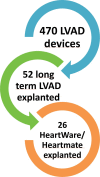A detailed explantation assessment protocol for patients with left ventricular assist devices with myocardial recovery
- PMID: 33236054
- PMCID: PMC8906770
- DOI: 10.1093/icvts/ivaa259
A detailed explantation assessment protocol for patients with left ventricular assist devices with myocardial recovery
Abstract
Objectives: Left ventricular assist device (LVAD) implantation for end-stage heart failure patients has been on the rise, providing a reliable long-term option. For some LVAD patients, longer term LV unloading leads to recovery; hence, the need for evaluating potential myocardial recovery and weaning eligibility has emerged.
Methods: All patients who underwent contemporary LVAD explantation at our institution between 2009 and 2020 were included in the study. Patients in New York Heart Association I, left ventricular ejection fraction >40%, a cardiac index >2.4 l/min and a peak oxygen intake >50% predicted underwent a 4-phase weaning assessment. A minimally invasive approach using a titanium plug was the surgery of choice in the most recent explants. Kaplan-Meier curves were used to estimate the survival at 1 and 5 years.
Results: Twenty-six patients (17 HeartMate II, 9 HeartWare) underwent LVAD explantation after a median 317 days of support [IQ (212-518)], range 131-1437. Mean age at explant was 35.8 ± 12.7 years and 85% were males. Idiopathic dilated cardiomyopathy was the underlying diagnosis in 70% of cases. Thirteen (48%) patients were on short-term mechanical circulatory support and 60% required intensive care unit admission prior to the LVAD implantation. At 1 year, Kaplan-Meier estimated survival was 88%, whereas at 6 years, it was 77%. The average left ventricular ejection fraction at 1 year post-explant was 44.25% ± 8.44.
Conclusions: The use of a standardized weaning protocol (echocardiographic and invasive) and a minimally invasive LVAD explant technique minimizes periprocedural complications and leads to good long-term device-free survival rates.
Keywords: Left ventricular assist device; Left ventricular assist device explantation; Minimal invasive approach; Myocardial recovery; Occlusion test.
© The Author(s) 2020. Published by Oxford University Press on behalf of the European Association for Cardio-Thoracic Surgery. All rights reserved.
Figures






Similar articles
-
Ventricular reconditioning and pump explantation in patients supported by continuous-flow left ventricular assist devices.J Heart Lung Transplant. 2015 Jun;34(6):766-72. doi: 10.1016/j.healun.2014.09.015. Epub 2014 Sep 28. J Heart Lung Transplant. 2015. PMID: 25447571 Free PMC article.
-
Myocardial recovery evaluation from ventricular assist device in patients with dilated cardiomyopathy.ESC Heart Fail. 2022 Aug;9(4):2491-2499. doi: 10.1002/ehf2.13951. Epub 2022 May 10. ESC Heart Fail. 2022. PMID: 35535672 Free PMC article.
-
Cardiac recovery following left ventricular assist device therapy: experience of complete device explantation including ventricular patch plasty.Eur J Cardiothorac Surg. 2021 Apr 29;59(4):855-862. doi: 10.1093/ejcts/ezaa461. Eur J Cardiothorac Surg. 2021. PMID: 33367693
-
Left Ventricular Assist Device Decommissioning Compared with Explantation for Ventricular Recovery: A Systematic Review.ASAIO J. 2020 Jan;66(1):17-22. doi: 10.1097/MAT.0000000000000926. ASAIO J. 2020. PMID: 30489294
-
The Effect of Left Ventricular Assist Device Therapy on Cardiac Biomarkers: Implications for the Identification of Myocardial Recovery.Curr Heart Fail Rep. 2018 Aug;15(4):250-259. doi: 10.1007/s11897-018-0399-3. Curr Heart Fail Rep. 2018. PMID: 29971612 Review.
Cited by
-
Novel Targets for a Combination of Mechanical Unloading with Pharmacotherapy in Advanced Heart Failure.Int J Mol Sci. 2022 Aug 31;23(17):9886. doi: 10.3390/ijms23179886. Int J Mol Sci. 2022. PMID: 36077285 Free PMC article. Review.
-
A Peek at LVADs Pumping to Recovery.Clin Med Insights Cardiol. 2022 Dec 26;16:11795468221144352. doi: 10.1177/11795468221144352. eCollection 2022. Clin Med Insights Cardiol. 2022. PMID: 36601071 Free PMC article.
-
Myocardial Recovery.Diagnostics (Basel). 2023 Apr 21;13(8):1504. doi: 10.3390/diagnostics13081504. Diagnostics (Basel). 2023. PMID: 37189604 Free PMC article. Review.
-
HeartMate 3 Explantation Using Felt Plug for Ventriculotomy Occlusion.Methodist Debakey Cardiovasc J. 2023 May 8;19(1):43-48. doi: 10.14797/mdcvj.1208. eCollection 2023. Methodist Debakey Cardiovasc J. 2023. PMID: 37188100 Free PMC article.
-
A Holistic View of Advanced Heart Failure.Life (Basel). 2022 Aug 24;12(9):1298. doi: 10.3390/life12091298. Life (Basel). 2022. PMID: 36143336 Free PMC article. Review.
References
-
- Virani SS, Alonso A, Benjamin EJ, Bittencourt MS, Callaway CW, Carson AP et al. Heart disease and stroke statistics-2020 update: a report from the American Heart Association. Circulation 2020;141:e139–596. - PubMed
-
- Slaughter MS, Rogers JG, Milano CA, Russell SD, Conte JV, Feldman D et al. Advanced heart failure treated with continuous-flow left ventricular assist device. N Engl J Med 2009;361:2241–51. - PubMed
-
- Birks EJ, Tansley PD, Hardy J, George RS, Bowles CT, Burke M et al. Left ventricular assist device and drug therapy for the reversal of heart failure. N Engl J Med 2006;355:1873–84. - PubMed
MeSH terms
LinkOut - more resources
Full Text Sources

